by James Michaud
Every fall, East Coasters who’ve been saving their pennies, vacation days, and frequent flyer miles, perusing Top Ten lists, and begging for inside info on forums for a major destination visit eventually are forced to deal with the “this bed is too big; this bed is too small; this bed is just right” quandary. It’s the same deal no matter where you go, but when planning a transatlantic ski trip to the Alps, there’s an added wrinkle: the kid-in-a-candy-store variable — the possibility to experience the world’s largest lift-connected ski regions with skiable acreage in the tens of thousands and hundreds of miles of marked trails.
Spending a week at a circuit that’s multiple times as big as Whistler or Vail is, no question, a bucket-list experience for us northeasterners. At the same time, there’s an equally compelling value proposition for the dozens of lesser-known regions boasting ski areas that are still far larger and more varied than anything on this side of the pond, but small enough not to feel like a winter-vacation processing plant.
That’s why last season I decided to sample a part of the Alps that’s barely a blip on the radar of North American skiers, but has established itself as an inside tip among Europeans trying to avoid the industrial tourism meat grinder: the Vorarlberg province on Austria’s western border, easily reached from the East Coast via nonstop flights to Zürich. Following a mid-evening departure out of JFK, I arrived at 10:30 the next morning, grabbed a rental car, and drove east alongside scenic Lake Constance framed by the western edge of the Alps in the distance. Even though it was a Saturday at the end of January, there was virtually no traffic on the east/west Swiss Autobahn. 90 minutes later, I arrived in the sub-region of Bregenzerwald (the Bregenz Forest), home not only to the snowiest part of the Alps, but also what’s known as “the cradle of alpine skiing.”
After dropping off non-essential items at my hotel in the tiny village of Au, I headed off to Diedamskopf (“Diedam’s Head”), the nearby “town hill” for three hours of arrival-day turns. While pumping a local in the parking lot for terrain recommendations, he warned me that “you’ll ski it out in a couple hours,” but this being the Alps, I knew that anything relating to size needed to be redefined for my comparatively modest reference points.
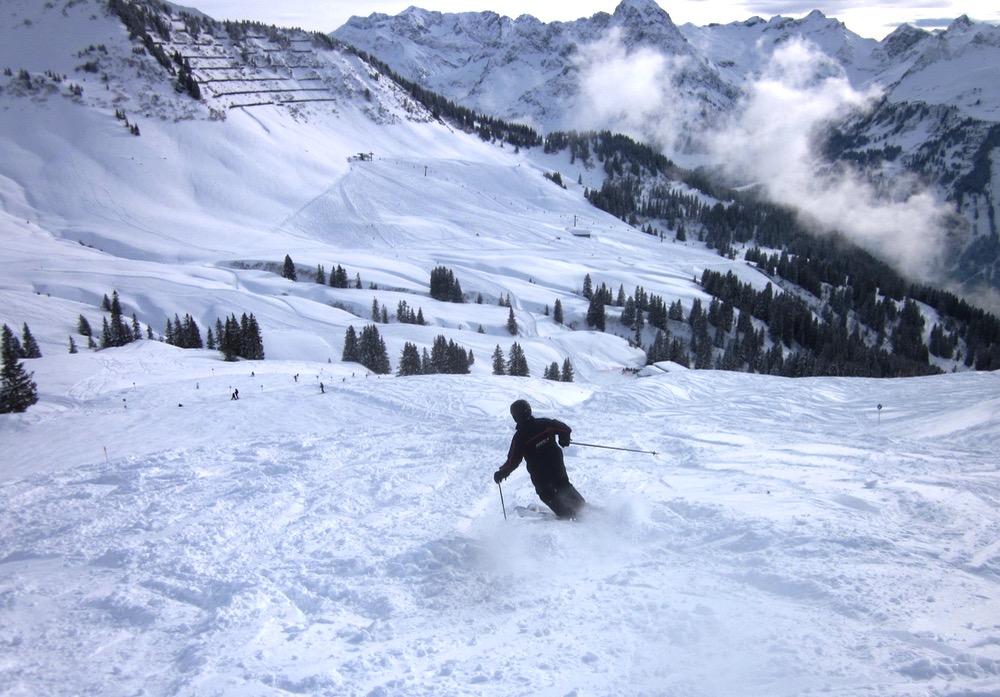
Like many ski areas here, you take a gondola from a wooded base area well below the treeline and ascend a couple thousand vertical feet to mid-mountain followed by a chair that brings you another couple thousand feet to the usable ski terrain: acres of treeless off-piste criss-crossed by beautiful rolling trails. If I’d had more time, I could’ve easily spent another day there.
I was pleasantly surprised to find that my accommodations at the Hotel Krone combined a sophisticated ambiance with creative, impeccably presented cuisine that rated high on the price/value scale. Convivial owner and proud Francophile, Herr Lingg, stopped by my table, saw my Gallic last name, and chatted with me for ten minutes in French. He and other locals mentioned that while the Vorarlberg is officially part of Austria, culturally and linguistically it has at least as much if not more in common with neighboring Switzerland (but thankfully without that country’s high prices). Although the tourist sector is a big part of the Bregenzerwald’s economy, the region felt picturesque and unspoiled, and featured numerous local food specialties, including its renowned cheese.
After sleeping off my jet lag, the next morning I headed up a steep, switch-backed road during a snowstorm to Warth-Schröcken, which averages 430 inches per year (in the same league as Utah’s Cottonwood Canyons), earning it the title of snowiest ski area in the Alps. Moreover, that figure is measured close to the base, so you can increase it for higher up on the mountain. While offering a comparatively modest 2,200 vertical feet, Warth skied big with lots of opportunity to score untracked snow only a few yards from the groomed trails. The one buzzkill of the visit was that the flurries and fog only cleared up intermittently, so most of the day was spent brailling my way along the markers at the edge of groomed trails (the entire ski area is above the treeline).
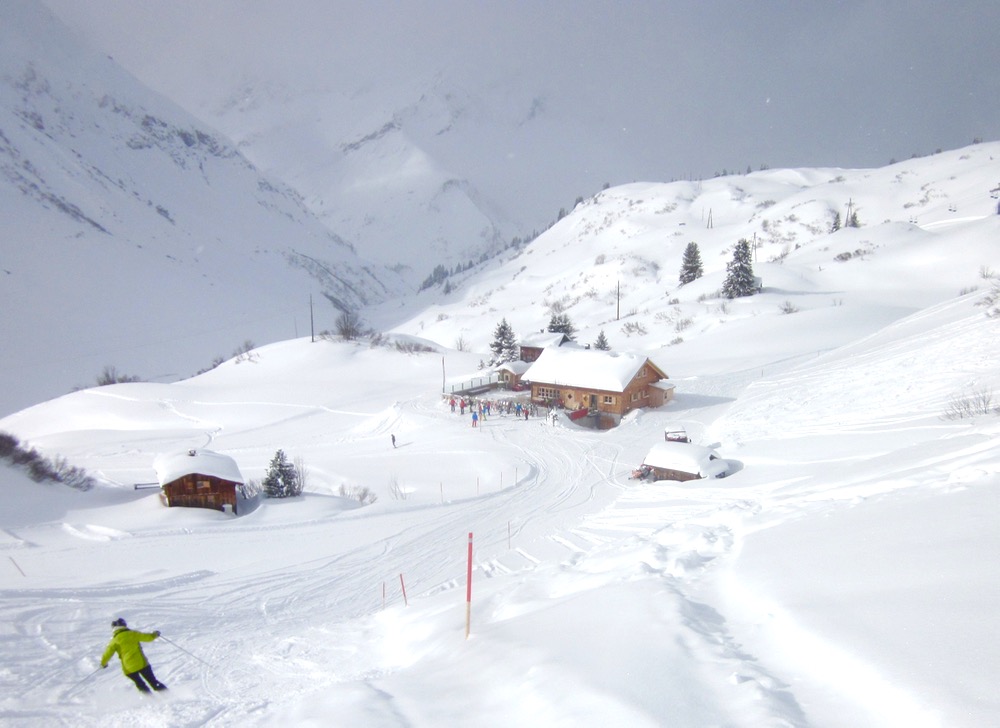
The day’s big adventure was the opportunity to check out the one-year-old gondola connection to neighboring Lech, resulting in a combined ski region with 210 miles of trails that mixed two very disparate cultures: Europe’s fur-clad gentry at Lech/Zürs and predominantly middle-class families at Warth-Schröcken. The new Auenfeld gondola is a fascinating (and, in all likelihood, very expensive) oddity — you ride it from Warth, up and around a bunch of peaks for about ten minutes before arriving at the bottom of Lech’s Weibermahd high-speed quad. But instead of getting off the gondola and walking over to the chair, the two lifts connect on a shared bullwheel, with two cars from the Auenfeld alternating counter-clockwise with one chair from the Weibermahd, over and over, and continuing uphill as a chondola.
Whereas Warth-Schröcken proclaims itself the snowiest Alps ski area, my Day 3 stop, Damüls, markets itself as the Alps’ snowiest village, complete with a great tagline, Willkommen im Schneereich: “Welcome to the Kingdom of Snow.” Seemingly on cue, Damüls lived up to its billing as I awoke the next morning at the cozy Alpenhotel Mittagspitze to find my rental car groaning under 16 inches of snow that had dropped since arriving at 4 pm the day before. I spent the first four hours storm-skiing through all that new powder, trying to stick close to any available trees on the lower mountain to improve my sight lines. Similar to my day at Warth, I reveled in nonstop powder but the trade-off was being deprived of the gorgeous views due to the whiteout.
While enjoying a fantastic lunch of Spätzle with the village’s marketing director back at the hotel, I learned that one of the challenges in getting new visitors to come to the region is how the name, Bregenzerwald (referring to a forest), leads people to believe that the ski areas here are big rounded hills, which certainly isn’t the case.
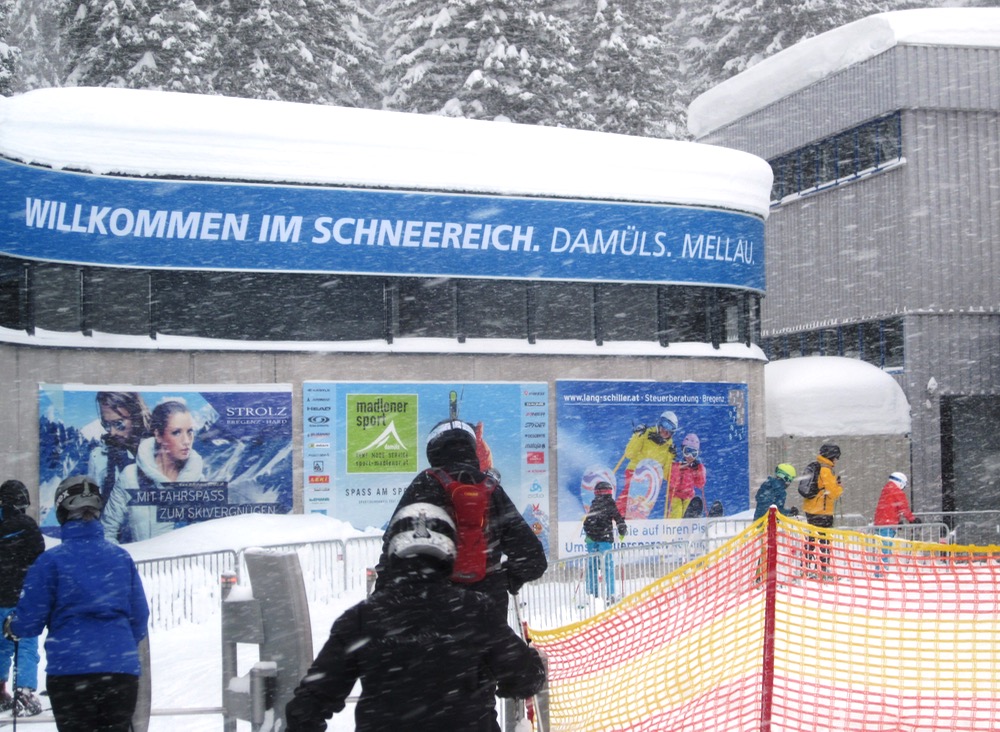
In another example of how locals in these smaller regions go out of their way to welcome people, while making his rounds around the restaurant during dinner that evening making sure that everyone was enjoying themselves, hotel owner Ingo Madlener not only invited me for a glass of the most delicious schnaps I’ve ever tasted, he later took me on a late-evening walking tour of the local sights. Some vacationers aren’t interested in learning the behind-the-scenes details of where they’re staying, but I always like when business owners explain to guests interesting back stories about what makes their village unique and why they’re proud of it.
On Day 4, I departed Damüls and drove 45 minutes in bright sunshine to Brandnertal (Brand Valley) — geographically located between the two sub-regions I’m visiting: Bregenzerwald and Montafon. Brandnertal consists of two previously separate ski areas, Brand and Bürserberg, that were connected eight years ago by a tram bridging a wooded valley just a few minutes from the medieval town of Bludenz, the headquarters of Milka chocolate. From an uphill-transport point of view, they couldn’t be any different. Bürserberg’s lifts are all decades-old fixed-grip chairs (which are becoming increasingly rare in Austria), while Brand has mostly new high-speed lifts. I started the day at Bürserberg on a veteran center-pole double chair and quickly saw that there was plenty of untracked leftovers from the previous two days’ precipitation.
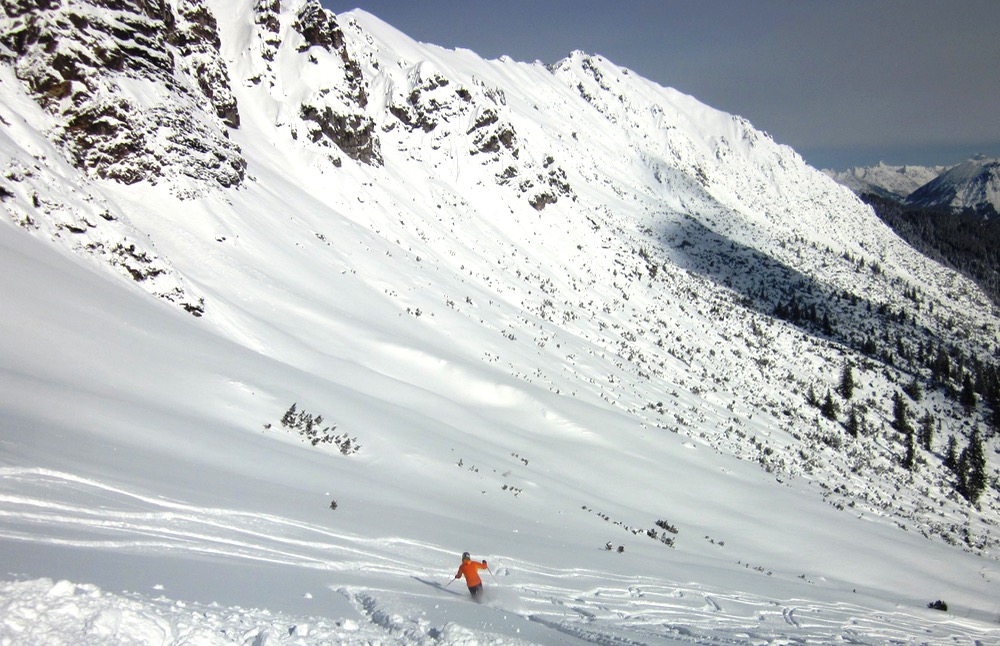
While Brandnertal is the very definition of family-friendly, it isn’t lacking in natural assets. With a tiny bit of exploration just a few yards from the groomed trails, I found all sorts of fun terrain and untouched powder. It was hard to believe that this unpretentious, small-to-them/not-to-me ski area is only a ten-minute drive from a major Autobahn and that it isn’t more well known.
From Brand, I headed 20 minutes southwest to the cute resort town of Schruns (pronounced “Shroonse”), the largest village in the sub-region of Montafon and possessing a storied history as a favorite winter vacation spot for celebrated American author Ernest Hemingway, who spent a fair amount of time earning turns there in the 1920s. Day 5 was at the largest ski area in the Vorarlberg, Silvretta Montafon. Just like Brandnertal, two separate ski areas were connected by a tram in 2008, resulting in 88 miles of marked trails, piles of off-piste, and a whole lot of continuous vertical.
Silvretta Montafon’s website details how the ski area has developed its own unique niche over the last few years. To differentiate itself from such well-known nearby regions as the Arlberg and Serfaus-Fiss, Silvretta Montafon developed a tagline and theme, “das sportlichste Skigebiet,” which translates not so smoothly into English as “the most sporting/athletic ski area.” When I first saw that moniker while doing research for this trip, I figured that it was pure marketing speak; however, Silvretta Montafon really does earn the name by offering numerous scheduled “experiences” that are divided into categories: athletic (sunrise skiing, freestyle park tour, night sledding, off-piste first tracks, freeriding, etc.), off-mountain (food-related, movies), and family-oriented. Some are self-guided; some are done with guides; others include instruction.

After perusing the long list of options, I decided on Hochjoch Totale, a variation of the classic sunrise ski run, where you get turns first thing in the morning before the lifts open to the public. What sets this apart from versions at other areas is its sheer size: 7.2 miles of trails covering 5,600 (!) continuous vertical feet. Everyone gathers in the early morning darkness at the mountain base, heads up to the summit where hot beverages are waiting, does some group stretching, and is then let loose all at once, similar to the starting gun at a marathon.
You can do the lower-intermediate run at your own pace — take breaks whenever you want or attempt to clean the entire top-to-bottom shot without stopping (some members of our throng did it in less than ten minutes). After meeting at the bottom, the group takes a gondola back up to a mid-mountain restaurant, where a gargantuan breakfast featuring local delicacies awaits. Here’s a condensed three-minute video of the experience.
Day 6 was something completely new for me — an all-day lift-assisted tour that began and ended at Gargellen, a small (compared to everything in the Alps) but interesting ski area 20 minutes from Schruns. Since the only touring I had done was many years back on unchallenging terrain, I figured that it’s now or never and made plans to do the “Madrisa Rundtour.” For experienced turn-earners, Madrisa is rated as technically easy but my ski-resort legs were hardly in top shape, to say nothing about my overall level of endurance.
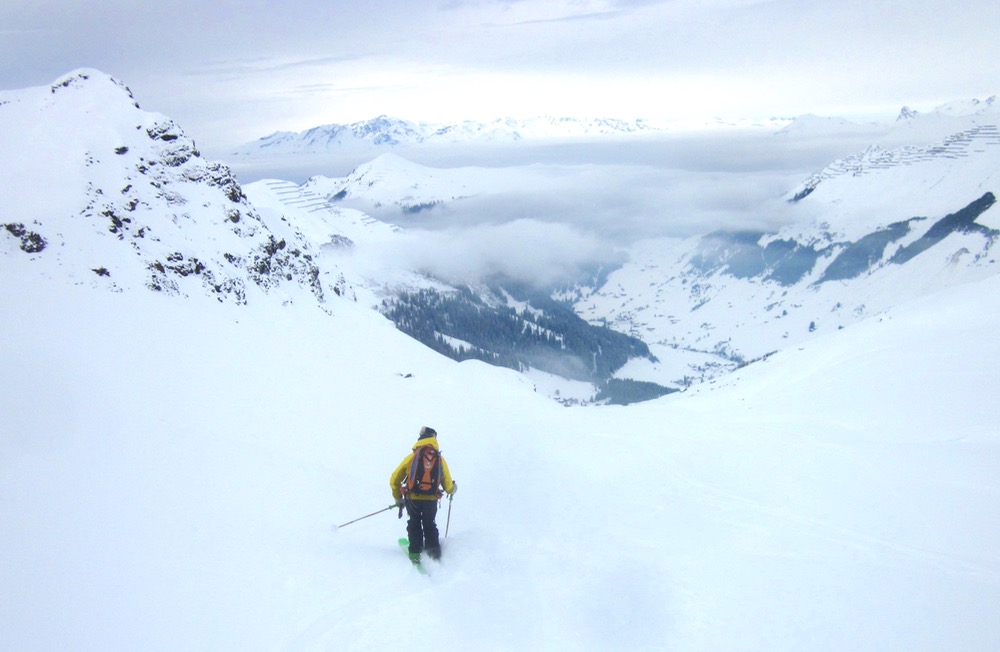
From the top lift, we skied down to the skin track and started our way up a little more than 1,000 verts. Throughout, my guide Jonny gave tips about proper form to avoid tiring inefficient movements, of which I had quite a few. We made it to the summit by 11 am, crossed the border into Switzerland, and started our descent. Given that this is a popular route, there would normally be some tracks, but due to the foggy weather and recent snow, we enjoyed untouched knee-deep powder the whole way down.
After skating into the sleepy village of St. Antönien for a break, we grabbed a taxi to shuttle us over to the Swiss resort of Klosters-Madrisa, took a gondola and two long t-bars, got some gorgeous untracked turns at the top, made a final 1,200-vert skin back to the Austrian border, and headed down into Gargellen for pizza and beer. A fantastic experience that would have only been improved by my being in better shape.
For Day 7, with my legs definitely feeling a bit shot after a week straight of skiing, I decided to take it easy, arrive in the late morning, and do some easy cruising in the sun. Just a few minutes away outside Schruns is a family ski area, Golm, with a 3,400-vert drop (and also an integral stop on the “Footsteps of Ernest Hemingway” regional tour). Locals mentioned that Golm offers some challenging terrain belying its family-friendly credo, including some impressive back- and sidecountry.
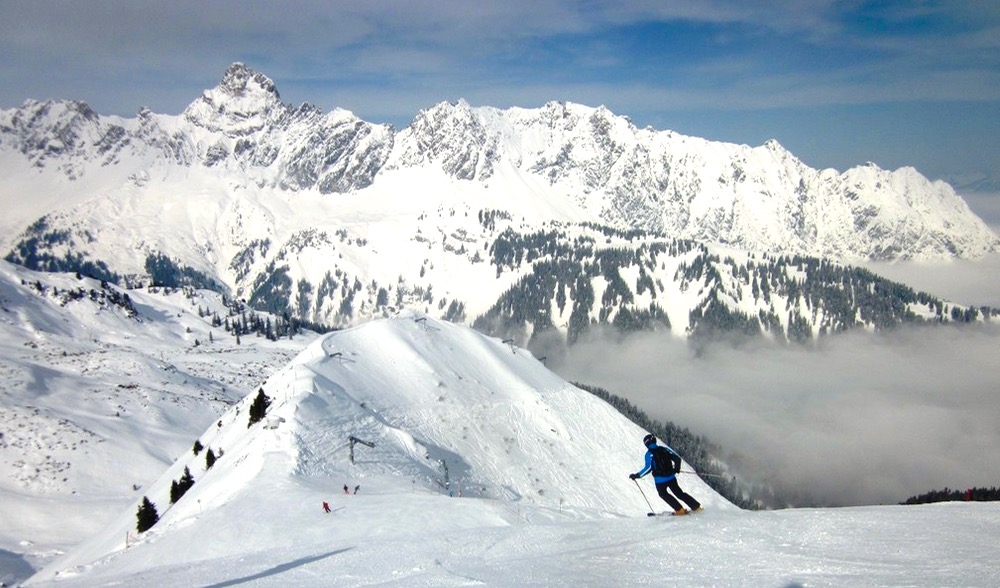
An hour later, I was back in Schruns enjoying a late-afternoon Fohrenburger beer while scanning through the dozens of photos I’d taken over the course of this very successful visit. Unsurprisingly, I would’ve preferred to have an extra week to investigate the region thoroughly. Needless to say, that’s the tradeoff for the road-trip format (a different ski area every day with lodging in three different villages) — you get a nice overview of a region and lots of variety, but there’s not enough time to more than scratch the surface, especially when even the smallest mountains on your itinerary are, by northeastern U.S. standards, sizable. Still, Vorarlberg confirmed itself as a great destination: easy to reach, plenty of snow, not too big/not too small, cute villages, excellent food, and friendly people.
For additional photos, info, and trail maps, check out the daily trip reports:
- Day 1: Diedamskopf
- Day 2: Warth-Schröcken
- Day 3: Damüls
- Day 4: Brandnertal
- Day 5: Silvretta Montafon
- Day 6: Madrisa Tour
- Day 7: Golm


I knew about Arlberg but not about Vorarlberg… me and my gf should go. Looks like less travel than Whistler Blackcomb.
If you put a NYSB group tour to Austria together, I’d sign up. Great article.
Really well written, fun read. Love the shot of the mid-mountain hut.